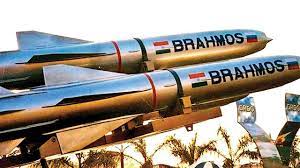04 Feb 2022 Exports of BrahMos: Philippines

- Recently Philippines has signed an agreement with BrahMos Aerospace Pvt Ltd for supply of shore based anti-ship version of BrahMos supersonic cruise missile. This is the first export order for this missile, which is a joint product of India and Russia.
- The Philippines wants to induct this missile amid tensions with China over disputed islands in the South China Sea.
- Many countries have shown interest in acquiring BrahMos missile. For example, discussions with Indonesia and Thailand are in advanced stages.
Features of BrahMos Missile:
- BrahMos is a joint venture between the Defense Research and Development Organization and NPOM of Russia.
- It is named after the Brahmaputra river of India and the Moskva river of Russia.
- It is a two-stage (solid propellant engine in the first stage and liquid ramjet in the second) missile.
- It is a multiplatform missile i.e. it can be launched with precision from land, air and sea and multi-capacity missile, which works in any weather day and night.
- It works on the principle of ‘fire and forget’ i.e. it does not require guidance after launch.
- BrahMos is one of the fastest cruise missiles, it currently operates with a speed of Mach 2.8, which is almost 3 times the speed of sound.
- Recently an improved version of BrahMos (extended range C-to-C variant) was tested.
- After India joined the Missile Technology Control Regime (MTCR) in June 2016, its range was increased to 450 km in the next phase and plans to expand to 600 kms.
- The BrahMos missile was initially fired at a range of 290 km.
Missile Technology Control Regime (MTCR):
- It is an informal and voluntary partnership between 35 countries to prevent the spread of missile and unmanned aerial vehicle technology, which is capable of carrying more than 500 kg of payloads to a distance of over 300.
- Those members are prohibited from supplying missiles and UAV systems that are controlled by non-members’ MTCRs.
- These decisions are taken with the consent of all the members.
- It is a non-treaty association of member states with a rules-based regulation mechanism for information sharing, national control laws and export policies for missile systems, and limiting the transfer of such critical technologies of these missile systems. There are some guidelines.
- It was established in April 1987 by the G-7 countries- USA, UK, France, Germany, Canada, Italy and Japan.
Status of India’s Defense Exports:
- Defense exports are a pillar of the government’s campaign to achieve self-reliance in defense production.
- More than 30 Indian defense companies have supplied arms and equipment to countries like Italy, Maldives, Sri Lanka, Russia, France, Nepal, Mauritius, Israel, Egypt, United Arab Emirates, Bhutan, Ethiopia, Saudi Arabia, Philippines, Poland, Chile and Spain etc.
- Exports include personal protective equipment, defense electronics systems, engineering mechanical equipment, offshore patrol vessels, advanced light helicopters, avionics suites, radio systems and radar systems.
- However, India’s defense exports have still not reached the expected limits.
- Stockholm International Peace Research Institute (SIPRI) has ranked India 23rd in the list of major arms exporters for the year 2015-2019.
- India still exports only 0.17% of the global arms.
- The reason for India’s disappointing performance in defense exports is that the Defense Ministry of India does not have any dedicated agency for exports as of now.
- The subject of export is left to individual corporations, such as ‘BrahMos’ or ‘Defence Public Shipyard’ and other undertakings.
- In this context, the KPMG report titled ‘Defense Exports: Untapped Potential’ recommends the first phase of setting up of a special “Defense Export Help Desk”.
- The report states that based on the inputs received from the help-desk, Indian companies can work with government machinery for exports.
- If India succeeds in providing a large military system to neighboring countries, it will not only boost defense exports, but will also be a strategic move to counter the influence of China, as it is in Pakistan, Bangladesh and Myanmar. Provides defense products to many countries in Asia.


No Comments